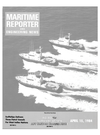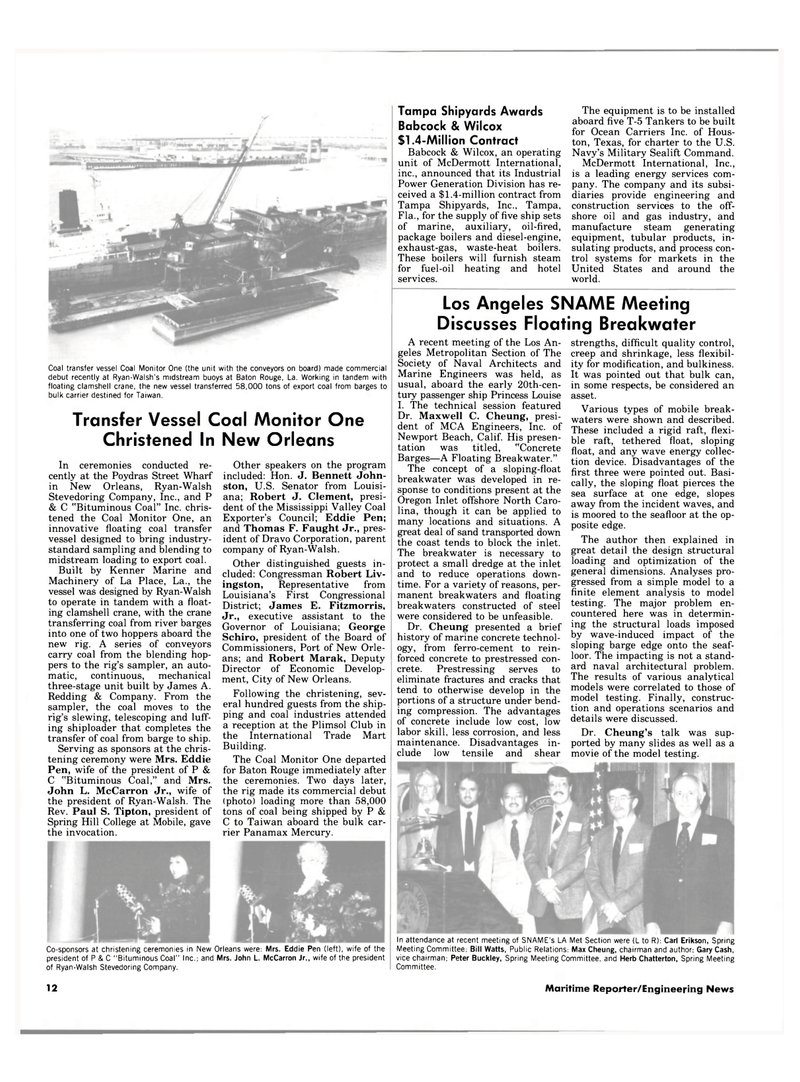
Page 10: of Maritime Reporter Magazine (April 15, 1984)
Read this page in Pdf, Flash or Html5 edition of April 15, 1984 Maritime Reporter Magazine
Coal transfer vessel Coal Monitor One (the unit with the conveyors on board) made commercial debut recently at Ryan-Walsh's midstream buoys at Baton Rouge, La. Working in tandem with floating clamshell crane, the new vessel transferred 58,000 tons of export coal from barges to bulk carrier destined for Taiwan.
Transfer Vessel Coal Monitor One
Christened In New Orleans
In ceremonies conducted re- cently at the Poydras Street Wharf in New Orleans, Ryan-Walsh
Stevedoring Company, Inc., and P & C "Bituminous Coal" Inc. chris- tened the Coal Monitor One, an innovative floating coal transfer vessel designed to bring industry- standard sampling and blending to midstream loading to export coal.
Built by Kenner Marine and
Machinery of La Place, La., the vessel was designed by Ryan-Walsh to operate in tandem with a float- ing clamshell crane, with the crane transferring coal from river barges into one of two hoppers aboard the new rig. A series of conveyors carry coal from the blending hop- pers to the rig's sampler, an auto- matic, continuous, mechanical three-stage unit built by James A.
Redding & Company. From the sampler, the coal moves to the rig's slewing, telescoping and luff- ing shiploader that completes the transfer of coal from barge to ship.
Serving as sponsors at the chris- tening ceremony were Mrs. Eddie
Pen, wife of the president of P &
C "Bituminous Coal," and Mrs.
John L. McCarron Jr., wife of the president of Ryan-Walsh. The
Rev. Paul S. Tipton, president of
Spring Hill College at Mobile, gave the invocation.
Other speakers on the program included: Hon. J. Bennett John- ston, U.S. Senator from Louisi- ana; Robert J. Clement, presi- dent of the Mississippi Valley Coal
Exporter's Council; Eddie Pen; and Thomas F. Faught Jr., pres- ident of Dravo Corporation, parent company of Ryan-Walsh.
Other distinguished guests in- cluded: Congressman Robert Liv- ingston, Representative from
Louisiana's First Congressional
District; James E. Fitzmorris,
Jr., executive assistant to the
Governor of Louisiana; George
Schiro, president of the Board of
Commissioners, Port of New Orle- ans; and Robert Marak, Deputy
Director of Economic Develop- ment, City of New Orleans.
Following the christening, sev- eral hundred guests from the ship- ping and coal industries attended a reception at the Plimsol Club in the International Trade Mart
Building.
The Coal Monitor One departed for Baton Rouge immediately after the ceremonies. Two days later, the rig made its commercial debut (photo) loading more than 58,000 tons of coal being shipped by P &
C to Taiwan aboard the bulk car- rier Panamax Mercury.
Tampa Shipyards Awards
Babcock & Wilcox $1.4-Million Contract
Babcock & Wilcox, an operating unit of McDermott International, inc., announced that its Industrial
Power Generation Division has re- ceived a $1.4-million contract from
Tampa Shipyards, Inc., Tampa,
Fla., for the supply of five ship sets of marine, auxiliary, oil-fired, package boilers and diesel-engine, exhaust-gas, waste-heat boilers.
These boilers will furnish steam for fuel-oil heating and hotel services.
The equipment is to be installed aboard five T-5 Tankers to be built for Ocean Carriers Inc. of Hous- ton, Texas, for charter to the U.S.
Navy's Military Sealift Command.
McDermott International, Inc., is a leading energy services com- pany. The company and its subsi- diaries provide engineering and construction services to the off- shore oil and gas industry, and manufacture steam generating equipment, tubular products, in- sulating products, and process con- trol systems for markets in the
United States and around the world.
Co-sponsors at christening ceremonies in New Orleans were: Mrs. Eddie Pen (left), wife of the president of P & C "Bituminous Coal" Inc.; and Mrs. John L. McCarron Jr., wife of the president of Ryan-Walsh Stevedoring Company.
Los Angeles SNAME Meeting
Discusses Floating Breakwater
A recent meeting of the Los An- geles Metropolitan Section of The
Society of Naval Architects and
Marine Engineers was held, as usual, aboard the early 20th-cen- tury passenger ship Princess Louise
I. The technical session featured
Dr. Maxwell C. Cheung, presi- dent of MCA Engineers, Inc. of
Newport Beach, Calif. His presen- tation was titled, "Concrete
Barges—A Floating Breakwater."
The concept of a sloping-float breakwater was developed in re- sponse to conditions present at the
Oregon Inlet offshore North Caro- lina, though it can be applied to many locations and situations. A great deal of sand transported down the coast tends to block the inlet.
The breakwater is necessary to protect a small dredge at the inlet and to reduce operations down- time. For a variety of reasons, per- manent breakwaters and floating breakwaters constructed of steel were considered to be unfeasible.
Dr. Cheung presented a brief history of marine concrete technol- ogy, from ferro-cement to rein- forced concrete to prestressed con- crete. Prestressing serves to eliminate fractures and cracks that tend to otherwise develop in the portions of a structure under bend- ing compression. The advantages of concrete include low cost, low labor skill, less corrosion, and less maintenance. Disadvantages in- clude low tensile and shear strengths, difficult quality control, creep and shrinkage, less flexibil- ity for modification, and bulkiness.
It was pointed out that bulk can, in some respects, be considered an asset.
Various types of mobile break- waters were shown and described.
These included a rigid raft, flexi- ble raft, tethered float, sloping float, and any wave energy collec- tion device. Disadvantages of the first three were pointed out. Basi- cally, the sloping float pierces the sea surface at one edge, slopes away from the incident waves, and is moored to the seafloor at the op- posite edge.
The author then explained in great detail the design structural loading and optimization of the general dimensions. Analyses pro- gressed from a simple model to a finite element analysis to model testing. The major problem en- countered here was in determin- ing the structural loads imposed by wave-induced impact of the sloping barge edge onto the seaf- loor. The impacting is not a stand- ard naval architectural problem.
The results of various analytical models were correlated to those of model testing. Finally, construc- tion and operations scenarios and details were discussed.
Dr. Cheung's talk was sup- ported by many slides as well as a movie of the model testing.
In attendance at recent meeting of SNAME's LA Met Section were (L to R): Carl Erikson, Spring
Meeting Committee; Bill Watts, Public Relations; Max Cheung, chairman and author; Gary Cash, vice chairman; Peter Buckley, Spring Meeting Committee, and Herb Chatterton, Spring Meeting
Committee. 12 Maritime Reporter/Engineering News

 9
9

 11
11
